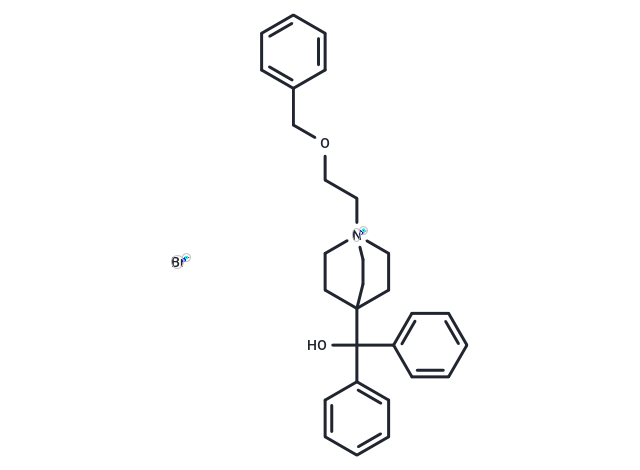Shopping Cart
- Remove All
 Your shopping cart is currently empty
Your shopping cart is currently empty

Umeclidinium bromide (GSK573719A) is a novel mAChR antagonist.

| Pack Size | Price | Availability | Quantity |
|---|---|---|---|
| 1 mg | $34 | In Stock | |
| 2 mg | $48 | In Stock | |
| 5 mg | $77 | In Stock | |
| 10 mg | $126 | In Stock | |
| 25 mg | $223 | In Stock | |
| 50 mg | $369 | In Stock | |
| 100 mg | $553 | In Stock | |
| 1 mL x 10 mM (in DMSO) | $89 | In Stock |
| Description | Umeclidinium bromide (GSK573719A) is a novel mAChR antagonist. |
| Targets&IC50 | M2 mAChR:0.15 nM(Ki), M4 mAChR:0.05 nM(Ki), M3 mAChR:0.06 nM(Ki), M1 mAChR:0.16 nM(Ki), M5 mAChR:0.13 nM(Ki) |
| In vitro | In human embryonic kidney 293 cells, Umeclidinium bromide (GSK573719A) inhibits the human ether-a-go-go-related gene channel tail current in a concentration-dependent manner (IC50 = 9.4 μM). |
| In vivo | Administering Umeclidinium bromide (GSK573719A) intranasally at a dose of 0.025 μg to mice once daily for five days incrementally enhances its inhibitory effect on bronchomotor tone, with inhibition increasing from 35% after the first dose to 60% by the fifth day. Following a five-day rest period, where bronchomotor tone reverts to baseline, a subsequent dose yields an inhibition level comparable to that of the initial dose, indicating the absence of tolerance development with repeated intranasal administration. Conversely, oral administration of Umeclidinium bromide at 2.0 mg/kg, equivalent to 100 times the intranasal ED50 value, fails to offer any protective effect against an Mch challenge, demonstrating the method-specific efficacy of this compound. |
| Animal Research | Mice:Age-matched male BALB/c mice (23-25 gm) are pretreated intranasally (50 μL per mouse) with vehicle (0.9% saline) or Umeclidinium bromide at intervals (0.25-48 hours) prior to methacholine challenge, and placed into individual plethysmograph chambers. Fresh air is supplied by bias flow pumps to the chambers. After baseline respiratory [enhanced pause (Penh)] values are collected, the mice received methacholine (30 mg/mL or EC80) by aerosol delivery (flow=1.6 mL/min×2 minutes). An average Penh is then calculated for 5 minutes. Penh=[(expiratory time/relaxation time)?1]×(peak expiratory flow/peak inspiratory flow), and relaxation time is the amount of time required for 70% of the tidal volume to expire. In some cases, animals are treated on multiple, consecutive days as described in the figure legends. The data are expressed as the mean±S.E.M. percent inhibition of Penh or (mean Penh value of vehicle treated group-Penh for each drug-treated animal) divided by (mean Penh value of vehicle treated group)×100%. Data are analyzed using commercially available software. |
| Alias | GSK573719A |
| Molecular Weight | 508.49 |
| Formula | C29H34BrNO2 |
| Cas No. | 869113-09-7 |
| Smiles | [Br-].OC(c1ccccc1)(c1ccccc1)C12CC[N+](CCOCc3ccccc3)(CC1)CC2 |
| Relative Density. | no data available |
| Storage | Powder: -20°C for 3 years | In solvent: -80°C for 1 year | Shipping with blue ice. | ||||||||||||||||||||||||||||||
| Solubility Information | DMSO: 34 mg/mL (66.86 mM), Sonication is recommended. | ||||||||||||||||||||||||||||||
Solution Preparation Table | |||||||||||||||||||||||||||||||
DMSO
| |||||||||||||||||||||||||||||||

Copyright © 2015-2025 TargetMol Chemicals Inc. All Rights Reserved.